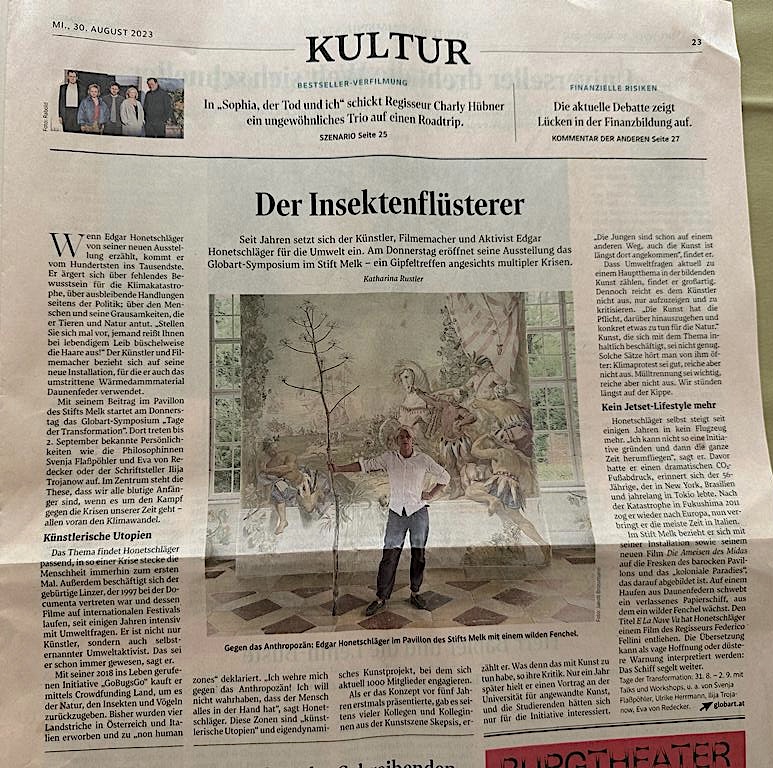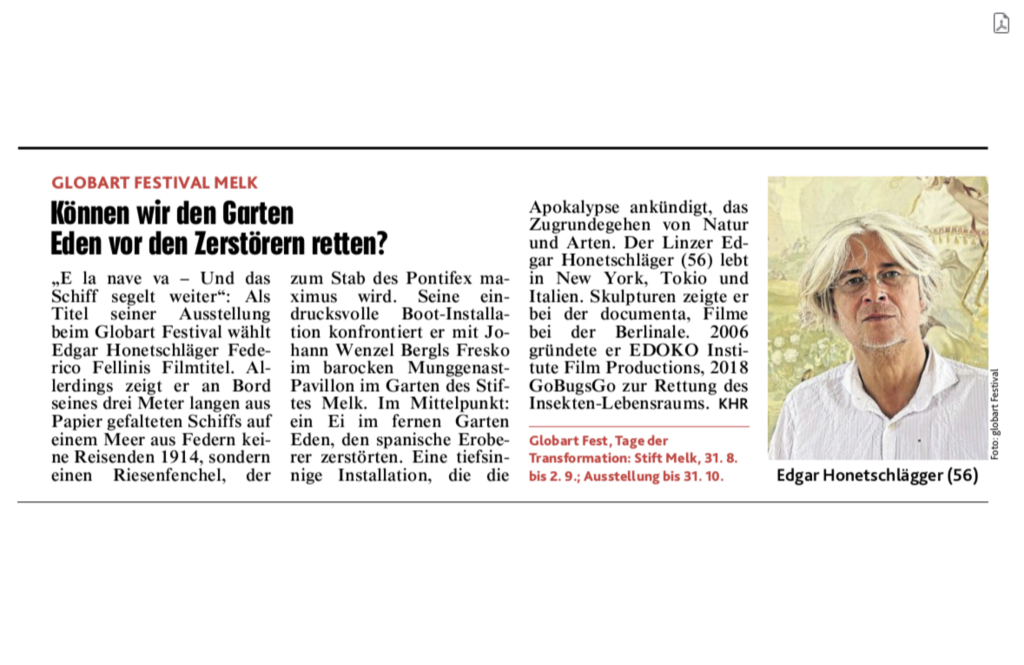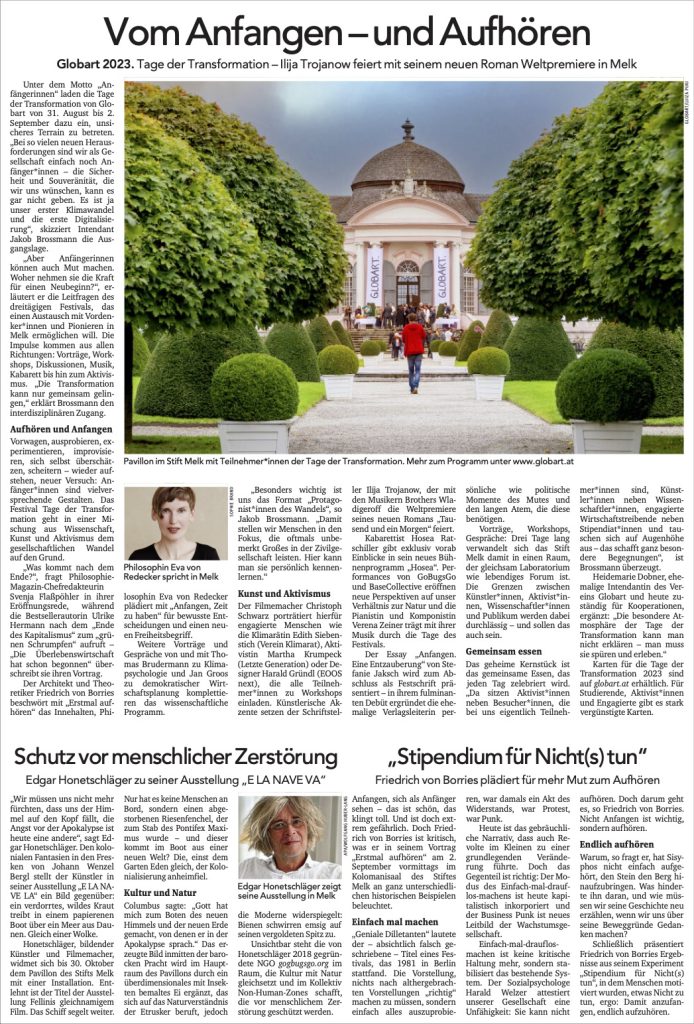Invited by GLOBART I realised an Installation at the Pavillon of the gardens of MELK abbey in lower Austria. The show was up from August 30th until October 31st 2023.
Radio Station OE1: conversation with Renata Schmidtkunz
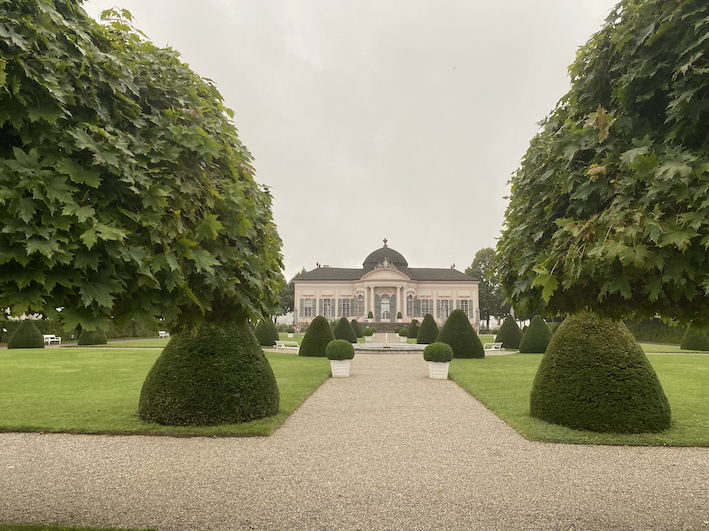
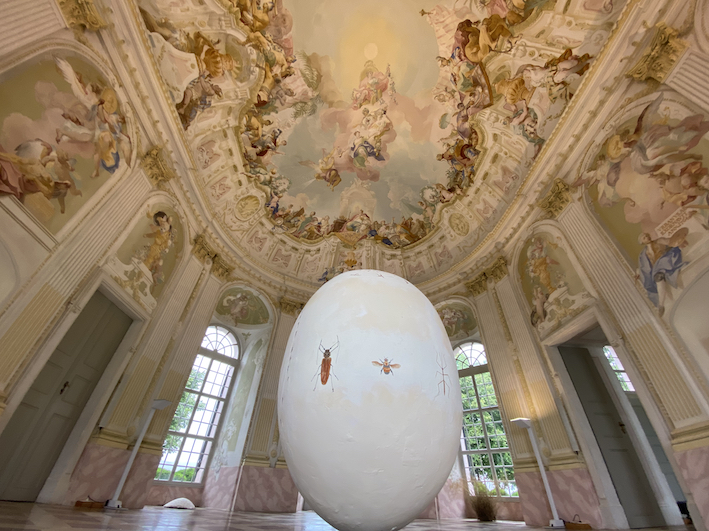
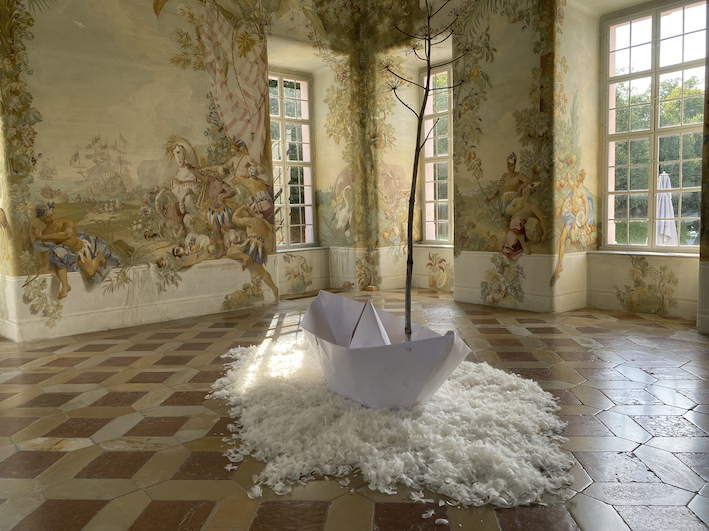
please scroll down for english and italian
Die Fresken im Hauptraum des Gartenpavillons des Stifts Melk von Johann Wenzel Bergl aus dem Jahr 1760 bilden den Triumph des Lichtes ab – Alles strebt zu ihm hin. Unter der barocken Pracht platziert der Künstler und Filmemacher Edgar Honetschläger ein überdimensionales Ei. An seiner Spitze trägt es einen Punkt aus Blattgold, Nektar auf den alle Bienen zustreben…
Honetschläger lebt vorwiegend in Tarquinia, nördlich von Rom, wo vor zweieinhalb Jahrtausenden die Etrusker weilten, dort wo sie bunt bemalte Grabstätten hinterliessen, die von einem Naturverständnis und einer Gleichberechtigung der Geschlechter zeugen, die im 21. Jahrhundert angesagt sind. Honetschläger bemalte das Ei mit Insekten in der Façon dieses mysteriösen Volkes und verweist damit poetisch auf das Faktum, dass die Welt in den letzten 20 Jahren rund 80% Insekten verloren hat. Menschen gibt es 200.000 Jahre, Insekten seit fünf Millionen. Der Verlust der Insekten ist gleichzusetzen mit dem des Menschen, denn wer soll bestäuben?
In der Nähe von etruskischen Grabstätten (Unesco Kulturwelterbe) darf es aus archäologischen Gründen keine Landwirtschaft geben. Und dort, nur dort kann die Natur tun und lassen was sie will d.h. die Hinterlassenschaften einer vergangenen Zivilisation schützen die Natur heute. An diesen Orten wächst ein Unkraut, der Ferula, ein wilder Riesenfenchel. Der Sage nach soll Prometheus den trockenen Stängel eines Riesenfenchels verwendet haben, um ihn am Sonnenwagen des Helios zu entzünden und den Menschen das Feuer zu bringen, das die Götter ihnen vorenthalten wollten. Später wird er zum Stab des Papstes. Ein Ferula ragt im Seitenflügel des Pavillons trocken und verdorrt empor, zu Bergls Himmel hin. Er steht in einem papierenen Boot, das, wie von Kinderhänden gefaltet, verschmutzt, zerrissen, aus Bergls neuer Welt zu kommen scheint. Eine Welt die, zum Zeitpunkt ihrer ‘Entdeckung’ dem Garten Eden gleich, der Kolonialisierung anheim fiel. Des barocken Malers Augen haben diese Welt nie geschaut, er hat sie interpretiert, fabuliert, fantasiert.
Das Barock wurde auf dem Rücken der Kolonien erschaffen. Columbus sprach: ‘Gott hat mich zum Boten des neuen Himmels und der neuen Erde gemacht, von denen er in der Apokalypse sprach.’ Das papierene Boot schwebt auf einer Wolke aus weichen Daunen, die oft Gänsen bei lebendigem Leib ausgerissen werden, um uns zu wärmen. Stellen sie sich vor ihnen reisst jemand die Haare aus…Arkadien. Aus Unschuld wurde Schuld. Honetschlägers fragiles Boot des 21. Jhdts. dient nicht Noah und den Tieren, es hat nur einen einzigen Passagier, eine verdorrte Pflanze.
In diesem Dialog zweier Künstler aus verschiedenen Jahrhunderten, geht es um die Kolonialisierung der Natur, und darum sie endlich in den demokratischen Errungenschaften miteinzubeziehen. Wieso dienen diese Prinzipien nur den Menschen? Alle Lebewesen auf dieser Erde haben das gleiche Recht in dieser Welt zu sein. Die Installation ist ein Spiegel unserer selbst. Lange haben wir gebraucht um auf einer Wolke zu landen, schwer ist es sie zu verlassen, denn obwohl die Zeiten Anderes erfordern, schweben wir immer noch auf ihr, auf der Wolke der Verweigerung der Realität. Wir haben die Pflicht, wie Papst Franciscus in seiner Enzyklika LAUDATO SI schreibt, die Schöpfung zu bewahren.
Unsichtbar steht die 2018 von Honetschläger mit Wissenschafterinnen gegründete NPO gogbugsgo.org im Raum, die Kultur mit Natur gleichsetzt und im Kollektiv Non-Human-Zones schafft, die vor menschlichem Eingriff geschützt werden. Hoffnung, denn nur gemeinsam werden wir die Wende schaffen. Es braucht UNS ALLE. Utopien kann man umsetzen, Dystopien sind passiv.
Der Titel dieser Ausstellung ist einem Film von Federico Fellini entlehnt. Wo würde er besser passen als im Stift Melk – an der Donau?
Edgar Honetschläger IM GESPRÄCH mit Renata Schmidtkunz auf Ö1: https://gobugsgo.org/oe1-da-capo17-11-2023/
The frescoes in the main room of the garden pavilion of Melk Abbey by Johann Wenzel Bergl from 1760 depict the triumph of light – everything strives towards it. Beneath the baroque splendor, artist and filmmaker Edgar Honetschläger places an oversized egg. At its tip, it carries a gold leaf dot, nectar toward which all bees strive….
Honetschläger spends most of the year in Tarquinia, north of Rome, where the Etruscans used to dwell two and a half millennia ago, where they left behind colorfully painted tombs that bear witness to an understanding of nature and gender equality that can serve as an example in the 21st century. Honetschläger painted the egg with insects in the façon of these mysterious people, poetically referring to the fact that the world has lost about 80% insects in the last 20 years. Humans have existed for 200,000 years, insects for five million. The loss of insects is equal to that of man, because who is to pollinate?
In the vicinity of Etruscan burial sites (Unesco World Heritage Site) there cannot b agriculture for archaeological reasons. And there, only there, nature can do what it wants i.e. the legacies of a past civilization protect nature today. In these places grows a weed, the Ferula, a wild giant fennel. According to legend, Prometheus used the dry stalk of a Ferula to ignite it on Helios’s sun chariot and therefore bring mankind the fire that the gods wanted to deprive them of. Later this wild fennel turns into the pastoral staff of the pope, the pontifex maximus. A Ferula plant rises dry and withered in the side wing of the pavilion, towards Bergl’s frescoed sky. It stands in a paper boat, which, as if folded by children’s hands, dirty, torn, seems to come from Bergl’s new world. A world that, at the time of its ‘discovery’ a Garden of Eden, fell prey to colonization. The baroque painter’s eyes have never seen this world, he interpreted it, fabulated, fantasized.
Baroque was created on the back of the colonies. Columbus said: ‘God has made me the messenger of the new heavens and the new earth, of which he spoke in the Apocalypse‘. The paper boat floats on a cloud of soft down feathers, which are often torn out from geese alive – to keep us warm. Imagine someone pulling out your hair… ARCADIA – innocence turned into guilt. Honetschläger’s fragile boat from the 21st century does not serve Noah and the animals, it has only one passenger, a withered plant.
This dialogue between two artists from different centuries is about the colonization of the natural world and how we finally need to include it in our democratic achievements. Why do its principles only serve humans? All living beings on this earth have the same right to be in this world. The installation is a mirror of ourselves. It took us a long time to land on a cloud, it is difficult to leave it, because although the times demand otherwise, we still float on it, on the cloud of denial of reality. We have the duty, as Pope Francis writes in his encyclical LAUDATO SI, to preserve creation.
Invisibly the NPO gogbugsgo.org stands in the room, founded in 2018 by Edgar Honetschläger with scientists, an institution that equates culture with nature and collectively creates non-human zones patches of nature that are protected from human interference. Hope, because only together will we turn the tide. It needs ALL of US. Utopias can turn into reality, dystopias are passive.
The title of this exhibition is borrowed from a film by Federico Fellini. Where would it fit better than here, at Melk Abbey on the Danube?
E LA NAVE VA
Gli affreschi realizzati nel 1760 da Johann Wenzel Bergl nella sala principale del padiglione del giardino dell’abbazia di Melk raffigurano il trionfo della luce, verso la quale tutto tende. Sotto questo splendore barocco, l’artista e regista Edgar Honetschläger colloca un uovo di grandi dimensioni con la punta impreziosita di foglia d’oro: il nettare che le api si impegnano a…
Honetschläger trascorre la maggior parte dell’anno a Tarquinia, a nord di Roma, dove più due millenni fa vivevano gli Etruschi, che hanno lasciato tombe dipinte a colori vivaci a testimonianza di una concezione della natura e dell’uguaglianza di genere che può ancora esserci di esempio nel XXI secolo. Honetschläger ha dipinto sull’uovo diversi insetti richiamando lo stile rappresentativo di questo popolo misterioso, un riferimento poetico al fatto che il mondo ha perso circa l’80% di insetti negli ultimi 20 anni. Gli esseri umani esistono da 200.000 anni, gli insetti da cinque milioni.
Possiamo mettere sullo stesso piano la perdita di insetti e quella dell’uomo? Chi ha il compito di impollinare?
Nelle vicinanze delle sepolture etrusche (Patrimonio dell’Umanità dell’Unesco) un vincolo impedisce l’attività agricola per proteggere il patrimonio archeologico. E lì, solo lì, la natura può fare ciò che vuole, in un luogo in cui i resti di una civiltà del passato proteggono la natura nel presente. Qui cresce la Ferula, un finocchio gigante selvatico. Secondo la leggenda, Prometeo accese il gambo secco di una Ferula e lo pose sul carro solare di Elio, così l’umanità ricevette il fuoco di cui gli dei volevano privarli. Successivamente questo finocchio selvatico fu usato anche per il bastone pastorale del papa, il pontifex maximus. Ed è una pianta di Ferula che si erge, secca e appassita verso il cielo affrescato da Bergl nell’ala laterale del padiglione, in una barchetta di carta sporca, strappata, come se fosse stata piegata da mani infantili. Sembra provenire dal nuovo mondo di Bergl, un ‘giardino dell’Eden’ al momento della sua ‘scoperta’ ora preda della colonizzazione. Gli occhi del pittore barocco non hanno mai visto questo mondo, lo hanno interpretato, hanno favoleggiato e fantasticato su di esso.
Il barocco è il risultato del processo di colonizzazione. Colombo disse: “Dio mi ha fatto messaggero dei nuovi cieli e della nuova terra di cui ha parlato nell’Apocalisse”. La barca di carta galleggia su una nuvola di soffici piume d’oca, che spesso vengono strappata alle oche vive, per tenerci al caldo. Immaginate che qualcuno vi strappi i capelli… ARCADIA – L’innocenza trasformata in colpa. La fragile barca di Honetschläger del XXI secolo non serve a Noè e agli animali e ha un solo passeggero, una pianta appassita.
Questo dialogo tra due artisti di secoli diversi riguarda la colonizzazione del mondo naturale e la necessità di includerlo nelle nostre conquiste democratiche. Perché i suoi principi sono solo a servizio dell’uomo? Tutti gli esseri viventi su questa terra hanno lo stesso diritto di stare al mondo. L’installazione è uno specchio di noi stessi. Ci è voluto molto tempo per atterrare su una nuvola ed è difficile lasciarla, perché, nonostante i tempi richiedano diversamente, continuiamo a galleggiare su di essa, sulla nuvola della negazione della realtà. Abbiamo il dovere, come scrive Papa Francesco nella sua enciclica LAUDATO SI’, di preservare il creato.
Nella stanza, invisibile, è presente l’organizzazione no-profit ‘gogbugsgo.org‘. Fondata nel 2018 da Edgar Honetschläger insieme ad alcuni scienziati, essa equipara la cultura alla natura e ha come obiettivo di istituire, lavorando tutti insieme, ‘zone non umane’, macchie di natura protette dall’interferenza umana, perché solo insieme riusciremo a invertire la rotta…speriamo. C’è bisogno di TUTTI NOI. Le utopie possono trasformarsi in realtà, ma le distopie sono passive.
